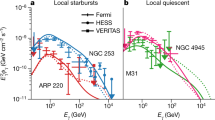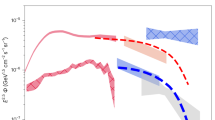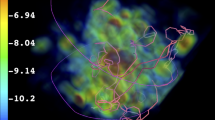Abstract
WE have recently shown1 that if one assumes that the far-infrared radiation2 is galactic, then inverse Compton scattering of these photons with cosmic ray electrons would explain the flux and the energy spectrum of diffuse X-rays. We also predicted a large anisotropy which seemed to be at variance with experimental data which indicated that diffuse X-rays are isotropic within about 10 per cent. Recent measurements by Cooke, Griffiths and Pounds3, however, now present evidence in support of the existence of anisotropy. They observed excess X-rays from the region of the galactic equator in the 1.4 to 18 keV region with an intensity of 0.3 photons (cm2 s rad)−1 near l = 260°, increasing to 0.5 near l = 300° in the Centaurus region. Perhaps these results indicate that the diffuse X-rays result from two separate mechanisms, one producing an isotropic component and the other an anisotropic component ! Thus, in the light of these new results, we feel it is worth while to look more closely at the predictions of our model regarding anisotropy. The X-ray flux I is directly proportional1 to the integration path-length L. Restricting our present discussion to the galactic equatorial plane corresponding to the measurements of Cooke et al.3, it follows by simple geometry that the X-ray flux at a longitude l, I(l) say, is proportional to  where R is the radius of the galaxy and a is the distance from the Earth to the centre of the galaxy. Taking a/R = 2/3 we obtain
where R is the radius of the galaxy and a is the distance from the Earth to the centre of the galaxy. Taking a/R = 2/3 we obtain  in good agreement with the value of 1.7 obtained by Cooke et al.3. We also obtain
in good agreement with the value of 1.7 obtained by Cooke et al.3. We also obtain  to be compared with the experimental upper limit3 of 3.3. This gives us added confidence in our model, but it is clearly desirable to have much more experimental confirmation of the anisotropy measured by Cooke et al.3.
to be compared with the experimental upper limit3 of 3.3. This gives us added confidence in our model, but it is clearly desirable to have much more experimental confirmation of the anisotropy measured by Cooke et al.3.
This is a preview of subscription content, access via your institution
Access options
Subscribe to this journal
Receive 51 print issues and online access
$199.00 per year
only $3.90 per issue
Buy this article
- Purchase on Springer Link
- Instant access to full article PDF
Prices may be subject to local taxes which are calculated during checkout
Similar content being viewed by others
References
O'Connell, R. F., and Verma, S. D., Phys. Rev. Lett., 22, 1443 (1969).
Shivanandan, K., Houck, J. R., and Harwit, M. O., Phys. Rev. Lett., 21, 1460 (1968); Houck, J. R., and Harwit, M., Astrophys. J. Lett., 157, L45 (1969).
Cooke, B. A., Griffiths, R. E., and Pounds, K. A., Nature, 224, 134 (1969).
Author information
Authors and Affiliations
Rights and permissions
About this article
Cite this article
O'CONNELL, R., VERMA, S. Have the Diffuse Cosmic X-rays an Anisotropic Component?. Nature 224, 505–506 (1969). https://doi.org/10.1038/224505a0
Received:
Issue Date:
DOI: https://doi.org/10.1038/224505a0
This article is cited by
-
X-Ray Stars and Infrared Excess
Nature (1970)
-
Infra-red astronomical background radiation
La Rivista del Nuovo Cimento (1970)
Comments
By submitting a comment you agree to abide by our Terms and Community Guidelines. If you find something abusive or that does not comply with our terms or guidelines please flag it as inappropriate.



